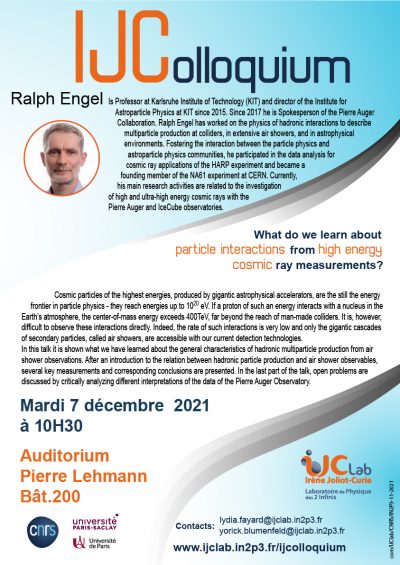IJColloquium: What do we learn about particle interactions from high energy cosmic ray measurements ?
 Cosmic particles of the highest energies, produced by gigantic astrophysical accelerators, are the still the energy frontier in particle physics - they reach energies up to 10 eV. If a proton of such an energy interacts with a nucleus in the Earth’s atmosphere, the center-of-mass energy exceeds 400TeV, far beyond the reach of man-made colliders. It is, however, difficult to observe these interactions directly. Indeed, the rate of such interactions is very low and only the gigantic cascades of secondary particles, called air showers, are accessible with our current detection technologies.
Cosmic particles of the highest energies, produced by gigantic astrophysical accelerators, are the still the energy frontier in particle physics - they reach energies up to 10 eV. If a proton of such an energy interacts with a nucleus in the Earth’s atmosphere, the center-of-mass energy exceeds 400TeV, far beyond the reach of man-made colliders. It is, however, difficult to observe these interactions directly. Indeed, the rate of such interactions is very low and only the gigantic cascades of secondary particles, called air showers, are accessible with our current detection technologies.
In this talk it is shown what we have learned about the general characteristics of hadronic multiparticle production from air shower observations. After an introduction to the relation between hadronic particle production and air shower observables, several key measurements and corresponding conclusions are presented. In the last part of the talk, open problems are discussed by critically analyzing different interpretations of the data of the Pierre Auger Observatory.
Lydia Fayard et Yorick Blumenfeld